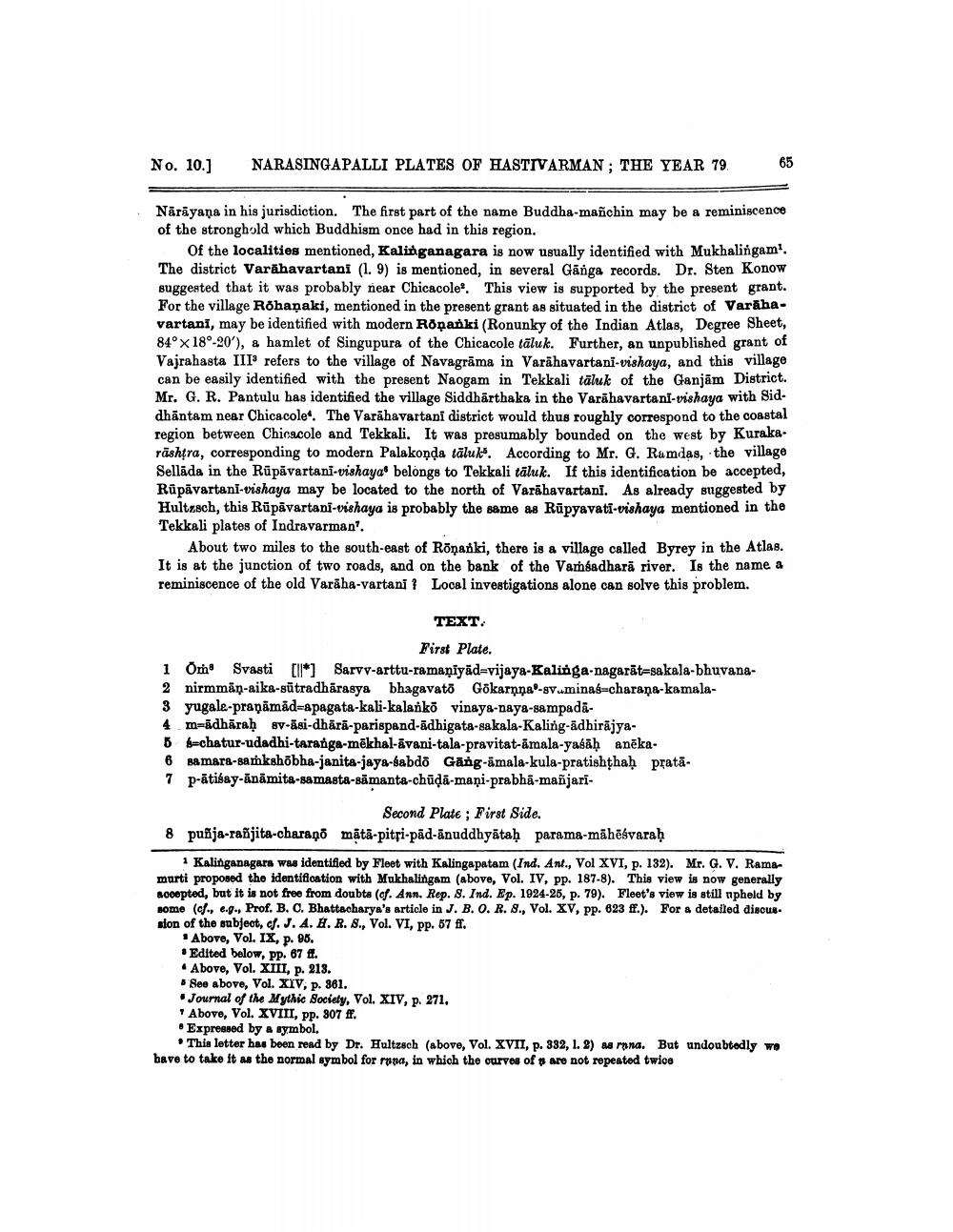________________
No. 10.]
NARASINGAPALLI PLATES OF HASTIVARMAN; THE YEAR 79
65
Nārāyana in his jurisdiction. The first part of the name Buddha-mañchin may be a reminiscence of the stronghold which Buddhism once had in this region.
Of the localities mentioned, Kalinganagara is now usually identified with Mukhalingam'. The district Varāhavartani (1.9) is mentioned, in several Gänga records. Dr. Sten Konow suggested that it was probably near Chicacole. This view is supported by the present grant. For the village Rohaņaki, mentioned in the present grant as situated in the district of Varahavartani, may be identified with modern Roparki (Ronunky of the Indian Atlas, Degree Sheet, 84° x 180-20'), a hamlet of Singupura of the Chicacole täluk. Further, an unpublished grant of Vajrahasta III' refers to the village of Navagrāma in Varahavartani-vishaya, and this village can be easily identified with the present Naogam in Tekkali täluk of the Ganjām District. Mr. G. R. Pantulu has identified the village Siddhārthaka in the Varāhavartani-vishaya with Sid. dhāntam near Chicacole. The Varāhavartani district would thus roughly correspond to the coastal region between Chicacole and Tekkali. It was presumably bounded on the west by Kuraka. rāshtra, corresponding to modern Palakonda tāluks. According to Mr. G. Ramdas, the village Sellada in the Rūpăvartani-vishayao belongs to Tekkali taluk. If this identification be accepted, Rūpävartani-vishaya may be located to the north of Varāhavartani. As already suggested by Hultzsch, this Rūpāvartani-vishaya is probably the same as Rūpyavati-vishaya mentioned in the Tekkali plates of Indravarman.
About two miles to the south-east of Rõnanki, there is a village called Byrey in the Atlas. It is at the junction of two roads, and on the bank of the Vamsadharā river. Is the name a reminiscence of the old Varāha-vartani ? Local investigations alone can solve this problem.
TEXT:
First Plate. 1 Om Svasti (lI*] Sarvv-arttu-ramaṇīyād=vijaya-Kalinga-nagarāt=sa kala-bhuvana2 nirmmän-aika-sūtradhäragya bhagavató Gökarnna-gvuminag-charana-kamala3 yugale-pranāmåd=apagata-kali-kalankö vinaya-naya-sampada4 m-adharah sv-asi-dhārā-parispand-ādhigata-sakala-Kaling-adhirājya8 fechatur-udadhi-taranga-mēkhal-āvani-tala-pravitat-amala-yabah anēka. 6 samara-samkshõbha-janita-jaya-babdo Gang-amala-kula-pratishthaḥ pratā. 7 p-atibay-ānāmita-samasta-bāmanta-chūdā-maņi-prabha-mañjari
Second Plate; First Side. 8 puñja-rañjita-charaņi mātā-pitfi-pād-ānuddhyātaḥ parama-māhēsvarah
Kalinganagara was identified by Fleet with Kalingapatam (Ind. Ant., Vol XVI, p. 132). Mr. G. V. Ramamurti proposed the identification with Mukhalingam (above, Vol. IV, pp. 187-8). This view is now generally accepted, but it is not free from doubts (cf. Ann. Rep. 8. Ind. Ep. 1924-25, p. 79). Fleet's view is still upheld by some (d., e.g. Prof. B. C. Bhattacharya's article in J. B. O. R. 8., Vol. XV, pp. 823 ff.). For a detailed discus. sion of the subject, cf. J. A. H. R. 8., Vol. VI, pp. 67 ff.
. Above, Vol. IX, p. 96. • Edited below, pp. 67 ft. . Above, Vol. XIII, p. 213. * See above, Vol. XIV, p. 861. • Journal of the Mythic Society, Vol. XIV, p. 271, *Above, Vol. XVIII, pp. 807 ff. • Expressed by a symbol.
. This letter has been read by Dr. Hultzsch (above, Vol. XVII, p. 382, 1. 2) asrana. But undoubtedly we have to take it as the normal symbol for runa, in which the curves of are not repeated twice




